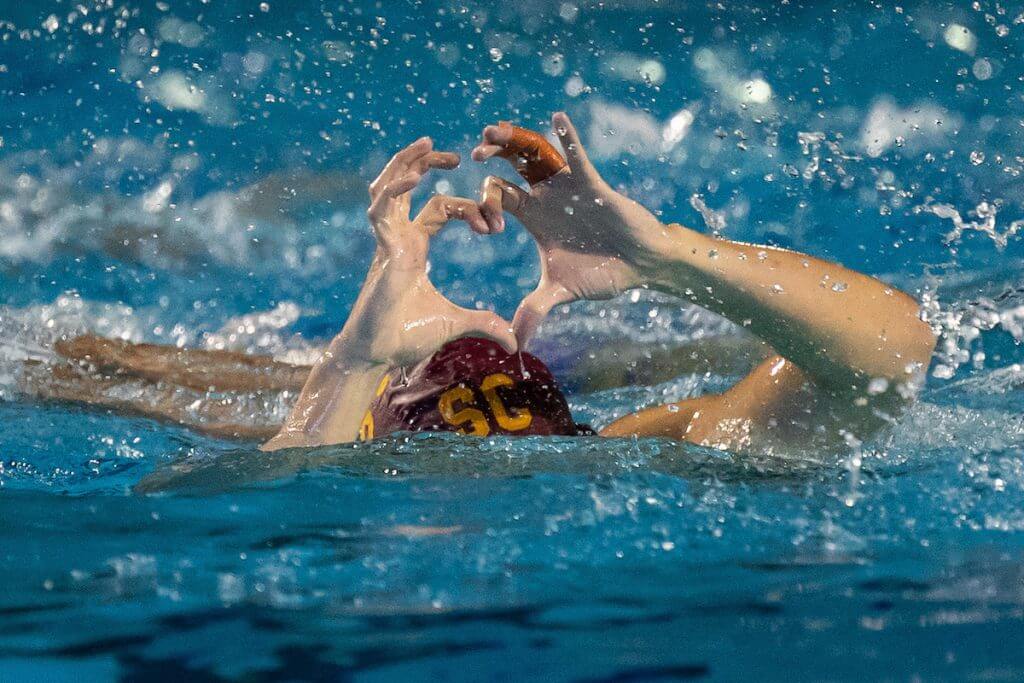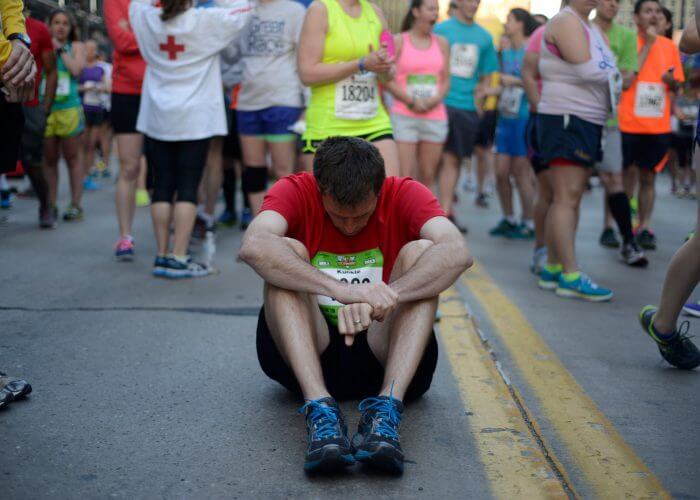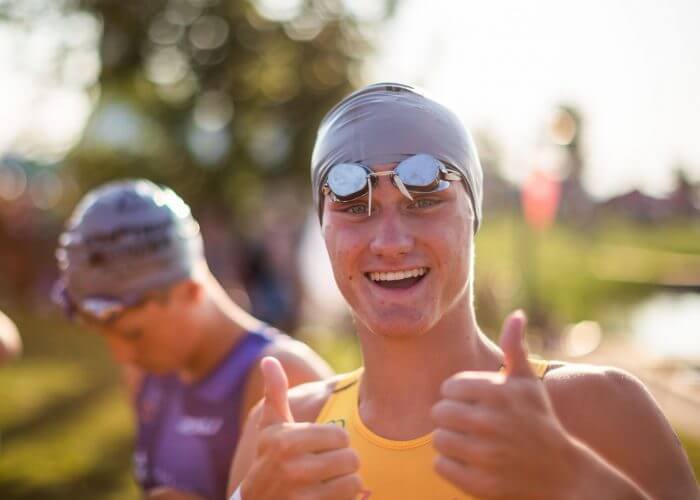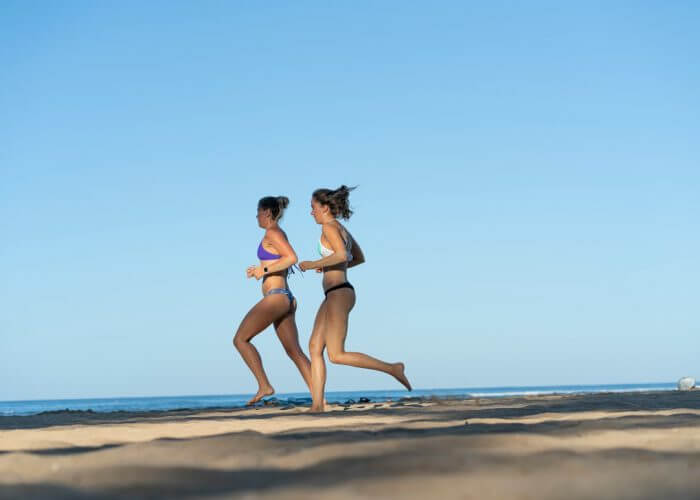Running vs. Swimming: Whose Heart Reigns Supreme?

By Sarah Noll, Swimming World College Intern.
We all know that exercise is good for us. As swimmers, we take pride in our sport being one of the most challenging activities both mentally and physically. It is a great cardio workout, is easy on the joints and can be relaxing. But sometimes, coaches like to cross-train to do more weight-bearing exercise. When this happens, many teammates bond together in a common hatred for the bane of dryland: running.
They can swim thousands of yards or meters every day, but if you put a swimmer on land, they typically flop like a fish. We groan inside when our coaches tell us that we are running for dryland. Now you’re in luck: research may be on our side. Eight researchers from Canada, the United States, and Switzerland may have found a physiological reason why swimmers tend to hate running.

Photo Courtesy: Facebook, @DSGPM
An Athlete’s Heart vs. A Non-Athlete
To understand the study and its conclusions, we must revisit the heart’s structure and function. The phenomenon of cardiac remodeling refers to the heart’s adaptations to increased demands of exercise. The heart – the left ventricular (LV) in particular – tends to change size, shape, structure and function in athletes and trained individuals. Because of the increased demand for blood supply and nutrients during training, athletes tend to have a larger and stronger LV than their inactive counterparts. Because of this adaptation, the heart “functions more efficiently, filling with blood a little earlier and more fully and untwisting with each heartbeat a bit more rapidly, allowing the heart to pump more blood more quickly,” Gretchen Reynolds of the New York Times explains.
While it is common knowledge that an athlete’s heart is typically much healthier than a sedentary person’s, the study of interest compares the heart structure and function between elite swimmers and runners. Does land-based exercise lead to different adaptations than water-based exercise? Read on to find out!
The Study

Photo Courtesy: Facebook, @USATriathlon, Archi Trujillo
Previous studies have compared the mechanics of the heart structures and adaptations between aerobic-trained and resistance-trained athletes. They have also compared land-based exercises such as running and rowing. However, very few, if any, studies exist comparing heart adaptations between land-based exercise versus swimming. “Therefore, the purpose of this study was to extend our understanding of the extent of exercise-induced cardiac remodeling with swimming through a characterization and comparison of LV (left ventricular) mechanics, dimensions, and global systolic and diastolic function between elite swimmers and runners,” the researchers explain.
In the study, 16 national team runners and 16 national team swimmers were given an echocardiogram after 12 hours of not exercising. An echocardiogram shows the shape of the heart and its efficiency through ultrasound waves. The researchers compared the cardiac output and speed at which “twisting” and “untwisting” of the atria and ventricles occurred. This natural and strenuous twisting of the heart’s chambers occurs when the heart is actively pumping the blood.
The LV – the last chamber in the heart where blood is pumped before entering the aorta and the rest of the body – is different in swimmers and runners compared to the rest of the population. It is not much of a surprise that those who participate in cardiovascular exercises like swimming and or running have a stronger heart than those who do not. The heart adapts after repeated exercise so that it can be more efficient. But significant differences between a swimmer’s heart versus a runner’s heart were also found.
The Conclusions

Photo Courtesy: Facebook, @Cardiologistshuja
Both groups of athletes displayed signs of great heart health. Both runners and swimmers had low average resting heart rates (swimmers: 56 vs. runners: 49 bpm). They also both had large, very efficient left ventricles. There was no statistically significant difference between LV size and systolic function (the working/pumping phase of the heartbeat).
However, some small differences were found between swimmers and runners in the diastolic (relaxation) phase of the heartbeat. “Our findings suggest enhanced early diastolic function in elite runners relative to swimmers, which may be attributed to faster LV untwisting,” the researchers explained. In layman’s terms, the runner’s LV relaxes more quickly and thus fills up with nutrient-rich blood earlier than the swimmer’s. This would enable the heart to pump more oxygen-rich blood to the body’s working muscles and back more quickly in a runner than a swimmer.
Implications

Photo Courtesy: Pexels
Although it may appear that a runner’s heart works better than a swimmer’s, that is not necessarily the case. Dr. Jamie Burr, professor at the University of Guelph and director of its human performance lab, explains that this adaptation may simply demonstrate the concept of training specificity. The body is an efficient machine that adapts to its demands; thus, the weight-bearing and positional differences between running and swimming yield slightly different adjustments that allow for both athletes to excel at their sport.
As written in the discussion section of the study, the researchers explain that because swimmers are horizontal in the water, the heart does not have to fight gravity to pump blood throughout the body. “Posture does some of the work for swimmers, and so their hearts reshape themselves only as much as needed for the demands of their sport,” Reynolds interprets from the study.
Posture is the most glaringly obvious difference in the cardiac demands of the two sports. Otherwise, both are regarded as great options for cardio exercise. Other studies have shown that swimmers and runners have similar oxygen intakes and cardiac outputs; however, swimmers have lower heart rates while swimming than runners do while running. The heart rate differences can be attributed to numerous factors, including temperature differences in the training environment and muscular activation.
All of this to say, swimmers who cross-train with running may struggle at first in part because of their slight differences as explained above.
Will Running Hurt my Swimming Career?

Photo Courtesy: Jonas Gutzat
So does that mean we should stop running? Not at all. Running can actually elevate your swimming career in that it can speed up and magnify the remodeling of your heart.
Although swimming is a great way to build endurance, strength and muscle tone, it does not help bone strength or density. This is where running comes in. As a weight-bearing exercise, running can supplement where swimming falls short. Cross training can help you get the best of both worlds.
Heart Health Across the Lifespan
According to Harvard Medical School, combining swimming with walking or running is the best way to stay active throughout your lifespan. Swimming is great for its low impact and relaxation effects as well as its full-body exercise component, while running is a great addition for joint and bone strengthening. Both are highly regarded modes of exercise when it comes to longevity.
What’s Next?
Because this was the first study of its kind, the researchers recommend additional exploration between swimmers’ and runners’ hearts. Therefore, a definitive scientific determination has not yet been made on the debate between the superiority of a runner’s heart versus a swimmer’s. “Further research is required to delineate whether these observations are a product of a superior exercise stimulus, or a necessary adaptation to promote filling during upright exercise,” the researchers conclude.
Although the study was inconclusive regarding whether the faster untwisting of the LV in runners equated to running being physically more demanding than swimming, maybe you can weigh in on the debate. Leave your experiences and thoughts in a comment below!
Link to the study discussed in the article: https://www.frontiersin.org/articles/10.3389/fphys.2018.01700/full
Currently, the research team is looking into how many miles a runner can log versus a swimmer before injury. They’re also studying if triathletes are benefiting from training both for distance running and swimming in addition to biking.
-All commentary is the opinion of the author. It does not necessarily reflect the views of Swimming World Magazine nor its staff. All research was conducted by the author and does not necessarily reflect the views of Swimming World Magazine nor its staff.




Alberto Lemes
Anne Emaus
As a swimmer and runner, both make make me smile for different reasons, I know I’m strange. I truly love both the sports and have ran three marathons two of which during my college swim career.
This is a very interesting read regarding both sides of swim and running. Thanks for sharing!
Love is love. Why does this have to be a contest?
Simon an Interesting read!
I like swimming and weight training. Sometimes running is cool but overall swimming and weight training works best for me.
Better yet, who has more problems with foot/knee injuries?
Johnny Karnofsky or shoulder problems
Kira Zubar